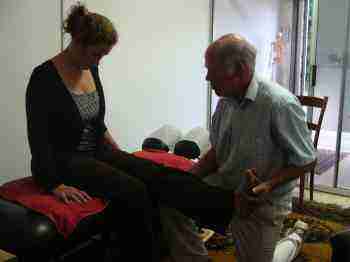- Home
- Slump Test
Slump Test for Sciatica
Slump test for sciatica places progressive stretch on the nerve; it's a part of the examination of the patient suffering from tingling in feet and legs; by flexing your head on the chest it tightens the meninges all the way from the neck to the lower back.
Then, when then examiner dorsiflexes your foot, and you bear down it, will elicit tightness in the leg and often the lower back if there is pressure on the nerve root.
This orthopaedic examination for a pinched nerve in the lower back is a complex manoeuvre that comes in a simpler form called the Flip test which you can do at home to discover if the tingling in your leg could be coming from your spine.
The lumbar spine supplies two main nerves that can cause tingling in the lower extremity. It's the onset of leg pain that gets the surgeon excited, and that you don't want obviously.
At our femoral nerve page you will appreciate that the pain and tingling from the lower back may radiate to the groin and top of the thigh, and the slump test will be negative. Instead we use a different procedure, which is far more difficult to administer, and has no place in a self help site such as this. It's best left to your chiropractor.
This page was last updated by Dr Barrie Lewis on 18th March, 2019.
Micro discectomy
Micro discectomy is a popular, minimally invasive procedure in the management of pain and tingling in feet and legs.
There's plenty of combined medical and chiropractic research for pinched nerves.
In interesting research, three neurosurgeons and a
chiropractor evaluated the effectiveness of micro discectomy versus
manipulation in a pilot study for patients with pain and tingling in the
feet and legs from a pinched nerve in the lower back. The slump test for sciatica would have been positive.
All forty patients had first undergone three months of conservative medical and physiotherapy without relief of the leg pain.
Slump test for sciatica
Slump test for sciatica is looking for confirmation that the pain in the back of the leg, for example, is not a pulled hamstring but a pinched nerve.

Actually, even that is an over simplification because the Flip and Slump tests are only for a pinched SCIATIC NERVE.
Results
After three months there was clear benefit in
- 85% of the the micro diskectomy group.
- 60% of the chiropractic research group.
- Seven of the eight patients who did not respond to chiropractic treatment responded well to a subsequent micro diskectomy, at the same rate and degree of benefit as the primary group. Nothing was lost by the delay of surgery.
- After twelve months there was little difference between the two groups.
- The recommendation of the researchers was that all patients with a pinched nerve in the back should first, because of the cost and risks, consider manipulative treatment before going on to surgery.
The cost of the chiropractic care was less than 10 percent of the surgery, with zero risks and side effects.
The Flip is a simplified version of the slump test for sciatica.
In the Flip test, you can assess an impingement of the sciatic nerve at home. Sit in an ordinary upright chair, and ask somebody else to raise first your good leg parallel to the ground, then lower it, remembering the pull behind your thigh and calf.
Now ask your examiner to raise the naughty leg. Is it significantly tighter or more painful than the other? If it hurts only in the back, not the lower limb, then you have no frank pinched nerve, but only the first stage of sciatica.
In the full slump test for sciatica, progressively more stretch is placed on the nerve but that is best left to an experienced chiropractor.
Micro diskectomy is a far less invasive procedure than normal back surgery; the surgeon is able, using an operating microscope, to remove a part of the facet joint or any disc material from under the nerve root.
Under risks, mention is made of recurrent herniations, immediately or later, cerebrospinal fluid leaks due to a wound of the dura, nerve root damage, bladder and bowel incontinence, bleeding and infection. The authors assure that these risks are relatively low; quite rare, they exclaim.
Tingling in legs and feet
Pain and tingling in legs and feet is a symptom that should not be ignored for a protracted length of time; the Slump test for sciatica helps you evaluate it; in difficult cases such as a herniation into the intervertebral foramen it may remain positive as the nerve remains inflamed if not actually still trapped.
Massaging bed rest is often required for a short period.
Unless the Slump test for sciatica eventually returns to normal, chronic back pain is the consequence; avoid it all costs even if it means taking a month or more off work.
How soon should you rush off to the doctor or chiropractor? It depends. Pain on the left side of the chest? I'd phone the emergency rooms right now. An old niggle in the back that you've had for years? No rush.
Having said that, last week my wife bent over, and twisted to lift a corner of the carpet for sweeping. She felt what she described as "a bottle exploding at the bottom of her back". Not good. She was stuck forwards in what we call an antalgic posture. The sign of Pisa. Because the swelling and inflammation hadn't yet started, the Slump Test for sciatica was negative. But wait three days... and I would have had drama on my hands, in the bosom of the family.
The long and the short of it is that I reduced that bulging disc within three hours of the injury, she spent the rest of the day in bed with an ice pack and doing half-hourly lower back exercises ...
A second treatment two days later, and within five days she is almost pain free during the day, except for prolonged sitting and early morning discomfort. Of course, I'm exhorting her to follow the 50 percent less pain rule. Today we'll start the rehab exercise program.
If there is any suggestion of leg pain muscle weakness then careful testing should be done. The progression from grade 3 to 4 or 5 can be insidious. Herniated disc foot drop.
More about home leg pain muscle testing in search of progressive weakness known in medical jargon as paresis. Can you raise your big toe off the ground?
Lower back exercises
- At Spine Health.com you can read about microdiscectomy spine surgery risks complications and success rates.
Chiropractic Help
Chiropractic help is the treatment of choice for nerve pain radiating down the back of the leg, calf and to the foot, but whether you go to a surgeon or a chiropractor, you will still have to rest up and go through rehabilitation whilst it's healing. The Slump test for sciatica will virtually always be positive.
In normal circumstances, if you wait a few weeks with leg pain before seeking the advice of your chiropractor, you will probably be in for extended treatment.
What's my point? When you know you've done a mischief to some part of
your body then it's better not to wait. Dealing with a disc herniation
when it's become swollen and inflammation has set in, is immeasurably more difficult.
Ringing in the changes before it starts referring down the leg, and the Slump test for sciatica is strongly positive, makes good sense. Likewise if you have a bad dose of bronchitis don't wait for the pleurisy before contacting your doctor.
I see little point in writing a story about Mr John who hurt his back, went to the chiropractor, who performed a miracle and he's again playing championship golf or tennis.
Such things do happen; actually quite regularly. But I prefer to write about the bizarre, funny and tragic things that happen at the chiropractic coalface. For such, I make no apology; take my books for what they are; controversial and fun.
My first three novels have been described by one fan as gems, both funny and healthful, from the life and work of a chiropractor. Such was not actually my intent but he has indeed hit the nail on the head. A patient with a brachial neuralgia turns out to be a blood diamond trader. A woman with acute low back pain is helped to the clinic by her lover, the parish priest.
A head on confrontation with a gynaecologist who refused to accept a referral from a chiropractor because he thought it would be unethical is typical. The reason for the referral is pertinent? An xray of her pelvis revealed an ancient IUD that a previous doctor had inserted some twenty years previously, and couldn't find to remove; titivating stories; you'll love them.
And now a new genre that I and many other people, Christian and those without religion, find difficult; homosexuality. A Family Affair is my take after a ten year search on the subject. Unless you're very straight, you'll love it; promise. It turned out to be so long that it's split into a trilogy; only 99c on Kindle, Nook, tablet or your smartphone. If you find it boring you can demand your money back and you'll get it; all 99c.

Dr Barrie Lewis DC = Dr Bernard Preston DC
Straight leg raise
Straight leg raise of Lasegue is the traditional test for sciatica. It has certain advantages, and some disadvantages; it complements the slump test for sciatica.
For example, in this L4 lumbar spine casefile the straight leg raise was strongly positive, as was the slump test for sciatica.
STONES IN MY CLOG
Stones in my clog is chiropractor Bernard Preston's third book of anecdotes from the clinic.
Not just about patients with a positive slump test for sciatica but the whole gamut conditions treated with chiropractic help.

If you have found these pages at Chiropractic Help useful, then you'll enjoy these anecdotes. Funny, tragic, absorbing stories about the people of Holland and their encounter with Chiropractic.
- Home
- Slump Test
Did you find this page useful? Then perhaps forward it to a suffering friend. Better still, Tweet or Face Book it.
